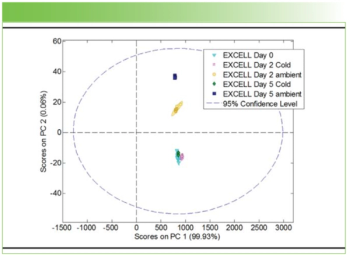
Revealing the Depths: Comparing SORS and Micro-SORS for Subsurface Material Analysis
A recent study explores the strengths and limitations of spatially offset Raman spectroscopy (SORS) and micro-SORS, offering new insights into their applications for non-invasive subsurface material analysis. The findings provide valuable guidelines for choosing between these techniques based on sample characteristics and analytical needs.
Introduction
In the world of material science and analytical chemistry, the ability to probe subsurface layers non-destructively is crucial for many applications, from cultural heritage preservation to biomedical diagnostics. Spatially offset Raman spectroscopy (SORS) has emerged as a promising technique for this purpose, offering insights into the inner layers of turbid materials. However, as the field evolves, a new variant, Micro-SORS, has been developed, aiming to provide higher spatial resolution for thinner layers. A recent paper published in Applied Spectroscopy compares these two techniques, shedding light on their respective advantages and optimal use cases (1).
Detailed Findings
The study, authored by Alberto, Claudia Conti, Alessandra Botteon, Sara Mosca, and Pavel Matousek from the Institute of Heritage Science at the National Research Council (CNR-ISPC), Sapienza University of Rome, and the Central Laser Facility at Harwell, delves into the theoretical and practical differences between SORS and micro-SORS. Both techniques have shown considerable promise in a variety of fields, particularly in cultural heritage analysis, but they cater to different analytical needs and scenarios (1,2).
SORS Overview
SORS operates by measuring Raman signals at various spatial offsets from the point of illumination. This technique is effective in analyzing turbid materials because it can retrieve signals from deeper layers within a sample. As the spatial offset increases, the intensity of the Raman signals typically decreases, primarily because fewer photons reach the detector. However, the study highlights that in a two-layer system, the signal from the top layer decays faster than that from the bottom layer. This decay pattern allows researchers to separate and analyze the contributions of different layers by normalizing the spectra to features indicative of the deeper layer (1).
Read More:
Micro-SORS Insights
Micro-SORS, a variant of SORS, utilizes microscope objectives for both excitation and collection, enabling the analysis of micrometric layers. This technique has been particularly useful in cultural heritage studies, where precise imaging of painted stratigraphies is essential. Micro-SORS provides higher spatial resolution compared to traditional SORS, making it suitable for applications requiring detailed imaging of surface and subsurface layers. However, the study notes that Micro-SORS can lead to higher laser intensity at the sample surface, potentially causing damage, especially in sensitive applications like cultural heritage conservation (1,2).
Key Differences and Considerations
The research paper elucidates several critical differences between SORS and micro-SORS. SORS covers a larger area of the sample, offering a better average signal from heterogeneous materials, albeit with lower spatial resolution. In contrast, micro-SORS, with its smaller excitation area, provides enhanced contrast between layers and more precise spatial offsets. The choice between these techniques depends on the nature of the sample and the desired outcome. For highly heterogeneous samples, SORS is preferable due to its ability to average the signal across a broader area. For homogeneous samples where high contrast and detailed imaging are required, micro-SORS stands out (1,2).
Applications and Practical Recommendations
The study's findings are illustrated through various applications, including cultural heritage and biomedical fields. For instance, Micro-SORS has demonstrated its efficacy in analyzing painted layers with high detail, while SORS has proven effective for assessing compounds diffusing into other materials. The paper provides practical guidelines for selecting between these techniques, emphasizing factors such as spatial resolution, signal averaging, and potential sample damage (1).
Conclusion
The comparative analysis of SORS and Micro-SORS offers valuable insights for researchers and practitioners seeking to optimize their analytical techniques for subsurface material analysis. By understanding the strengths and limitations of each method, users can better tailor their approach to meet specific analytical needs, whether they require high spatial resolution, signal averaging, or minimal sample impact. This study serves as a practical guide, enhancing the application of these advanced spectroscopy techniques in various scientific and industrial contexts (1).
References
(1) Lux A, Conti C, Botteon A, Mosca S, Matousek P. Theoretical and Practical Considerations of Spatially Offset Raman Spectroscopy (SORS) and Micro-SORS. Applied Spectroscopy. 2024;0(0). DOI:
(2) Vieira, M., Melo, M.J., Conti, C. and Pozzi, F. A combined approach to the vibrational characterization of medieval paints on parchment: Handheld Raman spectroscopy and micro‐SORS. Journal of Raman Spectroscopy, 2024, 55 (2), 263–275. DOI:
Newsletter
Get essential updates on the latest spectroscopy technologies, regulatory standards, and best practices—subscribe today to Spectroscopy.




